I was in a very contentious negotiation with the Senior Vice President of one of the top networking companies in the US. She was pushing me hard to reduce my price. She told me that my products and services  addressed a market that contributed little growth to their company, but they needed to maintain the market to avoid lost revenues. The company I was negotiating for was a midsize company that generated about $300M in revenues annually. Initially, it appeared that she had all the leverage. Afterall, they were a multibillion-dollar company who had resources and likely had many alternatives to choose from. This was an important deal for both of us, but it felt like it was more important for me than for her.
addressed a market that contributed little growth to their company, but they needed to maintain the market to avoid lost revenues. The company I was negotiating for was a midsize company that generated about $300M in revenues annually. Initially, it appeared that she had all the leverage. Afterall, they were a multibillion-dollar company who had resources and likely had many alternatives to choose from. This was an important deal for both of us, but it felt like it was more important for me than for her.
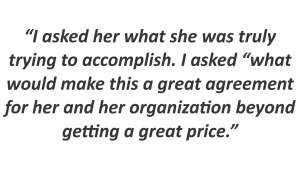 Many in this situation would seriously consider reducing their price to win the business and hopefully make it up in other opportunities that could materialize with them over time. Others might push back and remind her of the value they provide and how they reduce cost with their solution. But I took a different approach. I shifted the focus on her price position to understanding her underlying interests for this part of her business. I asked her what she was truly trying to accomplish. I asked, “what would make this a great agreement for her and her organization beyond getting a great price?” After asking many questions like this, it turns out that, ultimately, she wanted to show some growth for this business unit. Revenue growth didn’t seem like a possibility to her, so she focused on margin growth which is why she was trying to reduce cost. Her other business units were not meeting their growth goals either and she needed a win. So, that’s why she was pushing so hard for a reduction in price.
Many in this situation would seriously consider reducing their price to win the business and hopefully make it up in other opportunities that could materialize with them over time. Others might push back and remind her of the value they provide and how they reduce cost with their solution. But I took a different approach. I shifted the focus on her price position to understanding her underlying interests for this part of her business. I asked her what she was truly trying to accomplish. I asked, “what would make this a great agreement for her and her organization beyond getting a great price?” After asking many questions like this, it turns out that, ultimately, she wanted to show some growth for this business unit. Revenue growth didn’t seem like a possibility to her, so she focused on margin growth which is why she was trying to reduce cost. Her other business units were not meeting their growth goals either and she needed a win. So, that’s why she was pushing so hard for a reduction in price.
After learning this important information, I began to get some perspective about her position. I was also charged with growing my business unit and started to understand her motivation. I asked her if she would be open to a different approach that might positively impact growth. She said she would definitely listen. I requested a little time to think about the situation and come back with some alternative ideas that could better contribute to her goal of improving growth.
When I returned a few days later, I let her know that we had just developed a next generation solution that was getting great traction with our current users. I informed her that we had it deployed in several accounts and were getting great responses from the users. This next generation solution was helping our company grow revenues and it would surely help with revenue growth for her business unit as well. Our discussion went beyond price to the possibility of new revenue growth which was much more important to the SVP.
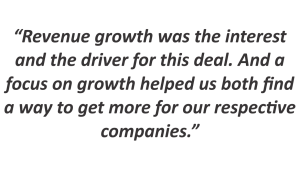 We came to an agreement that made us both very happy. The deal was more than double the revenue I originally thought possible. For her, it meant she could show a big win by driving new revenue into this stagnant business unit. Lowering the price was the easy way to achieve growth. But with a little more thought about her true interest and getting a better understanding of her perspective, it was no longer the best approach. Revenue growth was the interest and the driver for this deal. And a focus on growth helped us both find a way to get more for our respective companies.
We came to an agreement that made us both very happy. The deal was more than double the revenue I originally thought possible. For her, it meant she could show a big win by driving new revenue into this stagnant business unit. Lowering the price was the easy way to achieve growth. But with a little more thought about her true interest and getting a better understanding of her perspective, it was no longer the best approach. Revenue growth was the interest and the driver for this deal. And a focus on growth helped us both find a way to get more for our respective companies.
In my research I discovered that negotiators spend most of their time thinking about themselves and their own needs and requirements. They spend little time thinking about what the other side is trying to accomplish and why. It is critically important to put yourself in the other party’s shoes to get a sense of what they are trying to achieve with the deal. Often, there is not enough time problem-solving which involves more complex thinking. As a result, great value generating opportunities are simply overlooked, and that’s when bad deals happen. And bad deals happen all the time.
Perspective Taking vs. Empathizing
This idea of learning about the other party’s perspectives is what Adam Galinsky, of Columbia University calls “Perspective Taking”. He shows through experimentation that if we take the other party’s perspective, we  begin to understand their viewpoint. From there we can develop an appreciation for their situation and their motivations. This is not the same as empathizing. When we empathize, we focus on the other party’s feelings and emotions. We start to feel concern for their situation. It is important to differentiate between them as one offers great results and the other does not. Which of the two do you think provides better negotiation outcomes, empathizing or perspective taking?
begin to understand their viewpoint. From there we can develop an appreciation for their situation and their motivations. This is not the same as empathizing. When we empathize, we focus on the other party’s feelings and emotions. We start to feel concern for their situation. It is important to differentiate between them as one offers great results and the other does not. Which of the two do you think provides better negotiation outcomes, empathizing or perspective taking?
If you guessed perspective taking, you are right. Galinsky proves that negotiators that use perspective taking end up with outcomes where both parties are better off. When we use perspective taking, we are more effective at finding solutions that allow your counterpart to feel more satisfaction without sacrificing your own. However, if we empathize, we usually end up with an outcome where the other party is satisfied, but at your expense.[1]
What if you are in a different category that doesn’t use perspective taking or empathy? What if you are purely focused on your own interests and needs? What if your approach was more cutthroat and driven to winning at the expense of the other side? Don’t you think this category of people do better at getting the best negotiation outcomes?
The answer seems obvious right? If you guessed the cutthroats, hold that thought because there is startling research that may change your mind.
There are Three Kinds of People
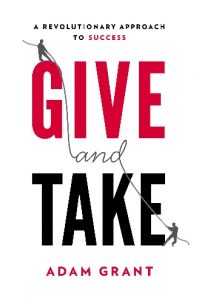 Adam Grant of The Wharton School at the University of Pennsylvania proves there are three kinds of people. There are takers, matchers, and givers. The takers are like the cutthroats. They are self-centered, focused on winning at other’s expense, and work hard at putting their own interests ahead of others. Matchers are more balanced. They tend to give and take, and will give only to get something in return. Matchers like a level playing field. Grant describes this as a tit-for-tat mentality where fairness is the goal through reciprocity. He states that most businesspeople fall into this category. Last, there are the givers who prefer to give more than they take. They tend to be more focused on others and their needs over their own. They give with no expectation of reciprocity which is the opposite of the takers and matchers. With these new categories defined, Grant asks readers of his book, Give and Take, which of these three do you believe end up with the best negotiation outcomes; the takers, matchers or givers?[2]
Adam Grant of The Wharton School at the University of Pennsylvania proves there are three kinds of people. There are takers, matchers, and givers. The takers are like the cutthroats. They are self-centered, focused on winning at other’s expense, and work hard at putting their own interests ahead of others. Matchers are more balanced. They tend to give and take, and will give only to get something in return. Matchers like a level playing field. Grant describes this as a tit-for-tat mentality where fairness is the goal through reciprocity. He states that most businesspeople fall into this category. Last, there are the givers who prefer to give more than they take. They tend to be more focused on others and their needs over their own. They give with no expectation of reciprocity which is the opposite of the takers and matchers. With these new categories defined, Grant asks readers of his book, Give and Take, which of these three do you believe end up with the best negotiation outcomes; the takers, matchers or givers?[2]
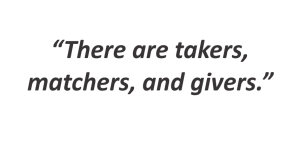 If you guess takers, you would be wrong. Surprisingly, it’s the givers. It may seem counterintuitive, but it turns out that more giving negotiators create bigger and better deals for both parties. I call these negotiators “collaborative” negotiators. But how can someone who gives with no expectation of receiving end up with a great outcome for themselves? Well, they can’t. It turns out there are two kinds of givers. One category of givers ends up with the worst negotiation outcomes and the other ends up with the best. The trick is to be the right kind of giver. Grant calls these highly successful givers otherish. These people do fit in the giver category, but they are not completely selfless givers. These givers have a very high concern for their own interests as well as their counterparts. However, since they have a giving tendency, they think differently about solutions to difficult problems. They exert more effort and complexity in their thought process which leads to win-win outcomes with extraordinary value drivers. They find ways to expand the overall opportunity for both parties creating more value to be shared. They GIVE more of themselves, their time, and resources to find what is hidden from the takers. Then, they claim some of the value to ensure that their interests are addressed as well as their counterparts.
If you guess takers, you would be wrong. Surprisingly, it’s the givers. It may seem counterintuitive, but it turns out that more giving negotiators create bigger and better deals for both parties. I call these negotiators “collaborative” negotiators. But how can someone who gives with no expectation of receiving end up with a great outcome for themselves? Well, they can’t. It turns out there are two kinds of givers. One category of givers ends up with the worst negotiation outcomes and the other ends up with the best. The trick is to be the right kind of giver. Grant calls these highly successful givers otherish. These people do fit in the giver category, but they are not completely selfless givers. These givers have a very high concern for their own interests as well as their counterparts. However, since they have a giving tendency, they think differently about solutions to difficult problems. They exert more effort and complexity in their thought process which leads to win-win outcomes with extraordinary value drivers. They find ways to expand the overall opportunity for both parties creating more value to be shared. They GIVE more of themselves, their time, and resources to find what is hidden from the takers. Then, they claim some of the value to ensure that their interests are addressed as well as their counterparts.
 I must admit to having some skepticism as I began to contemplate how givers or more collaborative negotiators could possibly end up with better outcomes for themselves. So, I put this concept to the test. I was in a negotiation where the other party was demanding exclusivity to ensure they were the only reseller of our new offering. None of the senior team that I was representing wanted to put all their eggs in one basket. It would limit their ability to sell through other channels and could have a drastic impact on overall sales results. By all accounts this was a deal breaker. I was so intrigued by the idea of collaboration and a more giving approach that I decided to try it here. What did we have to lose since we were at an impasse? I started asking the other party questions about why they wanted the exclusivity. It turns out they wanted to create a market advantage over the competition with the unique functionality of a single feature in our solution. They wanted to own the market for at least 18 months while their competitors tried to find a way to replicate it.
I must admit to having some skepticism as I began to contemplate how givers or more collaborative negotiators could possibly end up with better outcomes for themselves. So, I put this concept to the test. I was in a negotiation where the other party was demanding exclusivity to ensure they were the only reseller of our new offering. None of the senior team that I was representing wanted to put all their eggs in one basket. It would limit their ability to sell through other channels and could have a drastic impact on overall sales results. By all accounts this was a deal breaker. I was so intrigued by the idea of collaboration and a more giving approach that I decided to try it here. What did we have to lose since we were at an impasse? I started asking the other party questions about why they wanted the exclusivity. It turns out they wanted to create a market advantage over the competition with the unique functionality of a single feature in our solution. They wanted to own the market for at least 18 months while their competitors tried to find a way to replicate it.
I requested a short recess from the negotiation and took my team to a breakout room nearby. I asked them to consider giving on this concession. But not without thinking about how we could benefit as well. I formulated a question that helped us shift our thinking away from our position on exclusivity, and more on our interests. The question I asked was,
“Under what conditions would you be delighted to make any concession in the area of exclusivity for this deal?”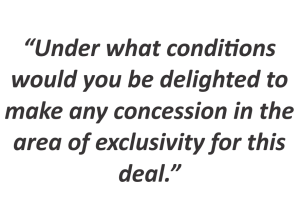
I asked the group to consider what we could offer that would increase the overall value of the deal, so that we could easily make a concession on exclusivity. The wheels started turning. Thinking became more complex. Finally, one person in the room stated the following:
“The other party is in three other markets with another provider. We have been trying to get that business for over seven years. Further, if they gave us those other markets, we could grant them exclusivity on that one feature in all markets and give them a significant market advantage over their competition. Let’s tell them that we would be happy to provide exclusivity on the one piece of functionality if it included choosing us for those three new markets as well. If they didn’t produce the necessary volume two quarters in a row, the exclusivity is dropped.”
They agreed to the terms. This resulted in a deal that was now four times bigger than we originally thought it would be, and the other party realized significant growth in market share. By all accounts, that’s an extraordinary outcome…for both parties.
How Collaborative Negotiators Drive Better Deals
William Ury, cofounder of Harvard’s Program on Negotiation (PON), refers to this level of complex thinking and problem solving as “looking for the third side.” He suggests that while most people feel there are only two sides to an argument, there are actually three sides to every argument. He has found that to discover the third side, it takes a deeper level of thought about the dispute that is stalling the deal making process. Ury describes the third side wonderfully through a story about a man who leaves a herd of 17 camels to his three sons as their inheritance.
“To the first son, he leaves half the camels; to the middle son, he leaves a third of the camels; and to the youngest son, he leaves a ninth of the camels. The three sons get into an intense negotiation over who should  get how many, because 17 doesn’t divide by two, or by three, or by nine. Tempers become strained, so in desperation they consult a wise, old woman. She listens to their problem and says, “Well, I don’t know if I can help you, but if you want, at least you can have my camel.” Now they have 18 camels, so the first son takes half of them, or nine camels; the middle son takes his third, or six camels; and the youngest son takes his ninth, or two camels. Nine plus six plus two adds up to a total of 17 camels. There is one camel left over, so the brothers give it back to the woman.”[3]
get how many, because 17 doesn’t divide by two, or by three, or by nine. Tempers become strained, so in desperation they consult a wise, old woman. She listens to their problem and says, “Well, I don’t know if I can help you, but if you want, at least you can have my camel.” Now they have 18 camels, so the first son takes half of them, or nine camels; the middle son takes his third, or six camels; and the youngest son takes his ninth, or two camels. Nine plus six plus two adds up to a total of 17 camels. There is one camel left over, so the brothers give it back to the woman.”[3]
Sometimes the best solution is not obvious. This is especially true when it comes to negotiating. So often deals get to a point where there is an impasse and the 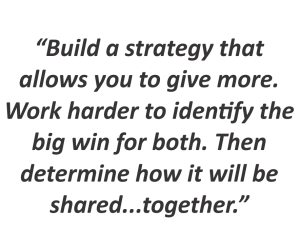 obstacle is too big to overcome. But, when we change our perspective and we consider a collaborative approach instead of holding or fighting for our position, we can improve the possibility of finding a better outcome for both parties. To achieve this kind of thinking and new level of problem solving, we need to think beyond ourselves and our needs. In other words, put yourself in the other party’s shoes, and show up with a plan to work together. Build a strategy that allows you to give more. Work harder to identify the big win for both. Then determine how it will be shared…together.
obstacle is too big to overcome. But, when we change our perspective and we consider a collaborative approach instead of holding or fighting for our position, we can improve the possibility of finding a better outcome for both parties. To achieve this kind of thinking and new level of problem solving, we need to think beyond ourselves and our needs. In other words, put yourself in the other party’s shoes, and show up with a plan to work together. Build a strategy that allows you to give more. Work harder to identify the big win for both. Then determine how it will be shared…together.
How To Drive Collaborative Negotiations
Since I discovered how well collaboration works for achieving exceptional deal outcomes that far surpass either party’s expectations, I will never go to the table without planning on working closely with the other party. In fact, I let the other party know that intention in advance. By signaling that we are coming prepared to work together to find the best outcome, we have set an expectation that our discussions will be collaborative. But what if the other party doesn’t want to collaborate? What if they insist that it is there way or the highway? What if they demand unfair terms to win at your expense?
The simple answer is you need tools to help drive cooperation between the parties. Not just any tools, but tools that have been tested and proven to work. We cannot leave this to chance, we need a sure-fire way to create a collaborative environment. I’m not talking about collaboration software platforms like Microsoft Teams or Trello. I’m suggesting there are psychological tools that are so very powerful, we can count on them to deliver results. In addition to the things we have already touched on such a perspective taking and being prepared to give, I have found that who you are negotiating with, timing of your negotiation, how you open a 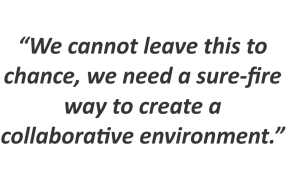 negotiation, your concession strategy, how you structure or architect your offers, and how you present them can have an incredible impact on collaboration. There are tools to drive perspective taking assessments and it starts with determining the other party’s interests as well as your own. It also involves forecasting the other party’s positions and looking past those by trying to understand their motivations. I have studied, tested, and proven this strategy with some of the most powerful collaboration tools available. I was introduced to many of these by academics, but I often found it difficult to take the academic findings and translate them to real world application. So, I had to trial each one in live negotiations. I found that some worked immediately, some only worked under certain circumstances, and some didn’t work at all. It’s been a career’s worth of work finding the path that gets to great deal outcomes consistently. It took an incredible amount of practice.
negotiation, your concession strategy, how you structure or architect your offers, and how you present them can have an incredible impact on collaboration. There are tools to drive perspective taking assessments and it starts with determining the other party’s interests as well as your own. It also involves forecasting the other party’s positions and looking past those by trying to understand their motivations. I have studied, tested, and proven this strategy with some of the most powerful collaboration tools available. I was introduced to many of these by academics, but I often found it difficult to take the academic findings and translate them to real world application. So, I had to trial each one in live negotiations. I found that some worked immediately, some only worked under certain circumstances, and some didn’t work at all. It’s been a career’s worth of work finding the path that gets to great deal outcomes consistently. It took an incredible amount of practice.
Lastly, very few know how to create and use the collaborative strategies and tools that are deployed by those who seem to magically bring home extraordinary win-win deals time and time again. It turns out that represents only about 4% of all negotiators.[4] Imagine being part of the 4% Club and the tremendous competitive advantage you will have in every negotiation to come.
Click here to find out more.
[1] Program on Negotiation/ Harvard Law School/ Daily Blog, March 15th, 2013/Dealmaking
[2] Give and Take, Adam Grant 2014 pgs. 4 – 9
[3] Ideas.ted.com; We Humans; There are Three Sides to Every Argument, William Ury, April 7, 2017
[4] Nadler, Thompson, & van Boven, 2003
